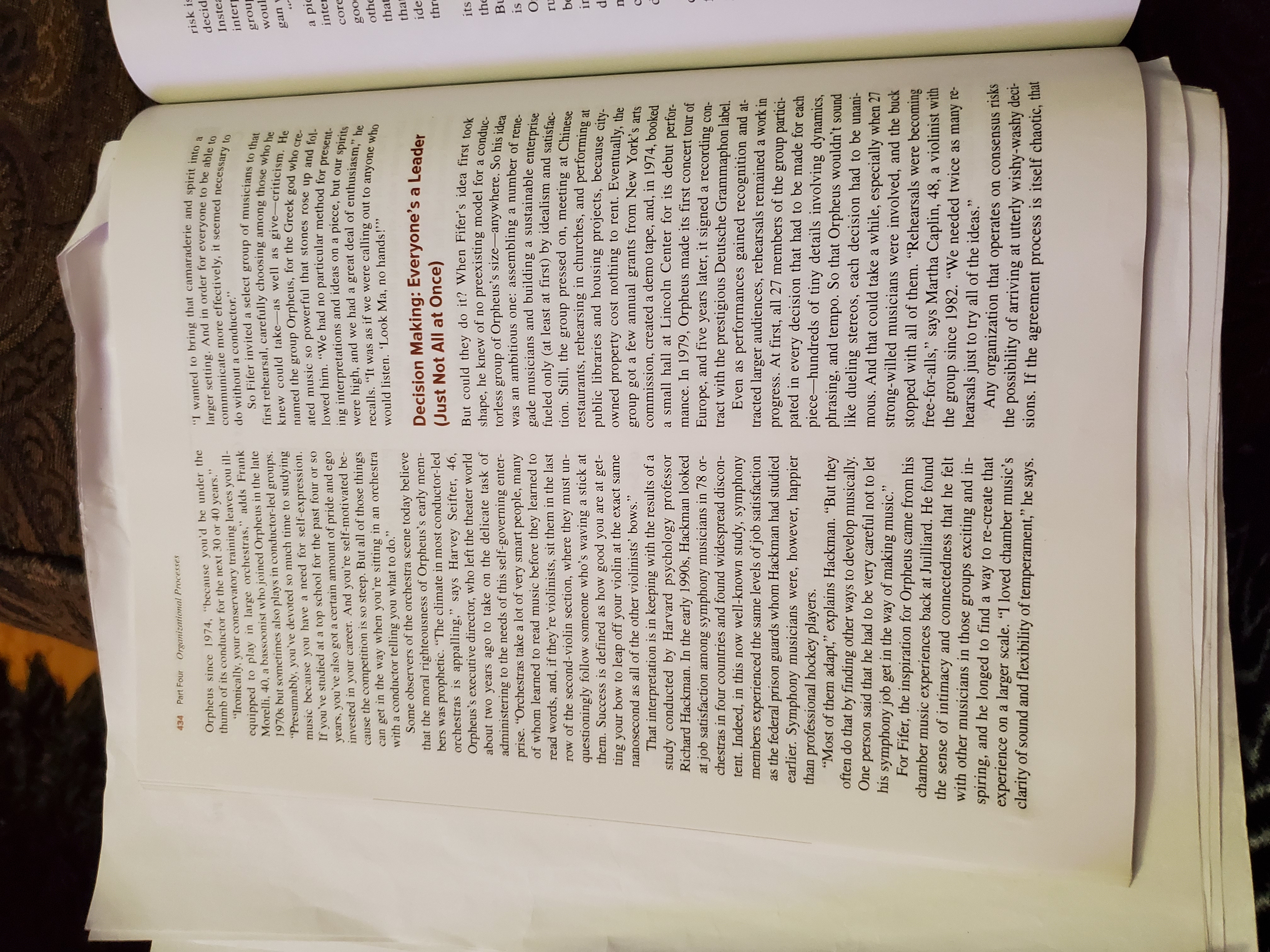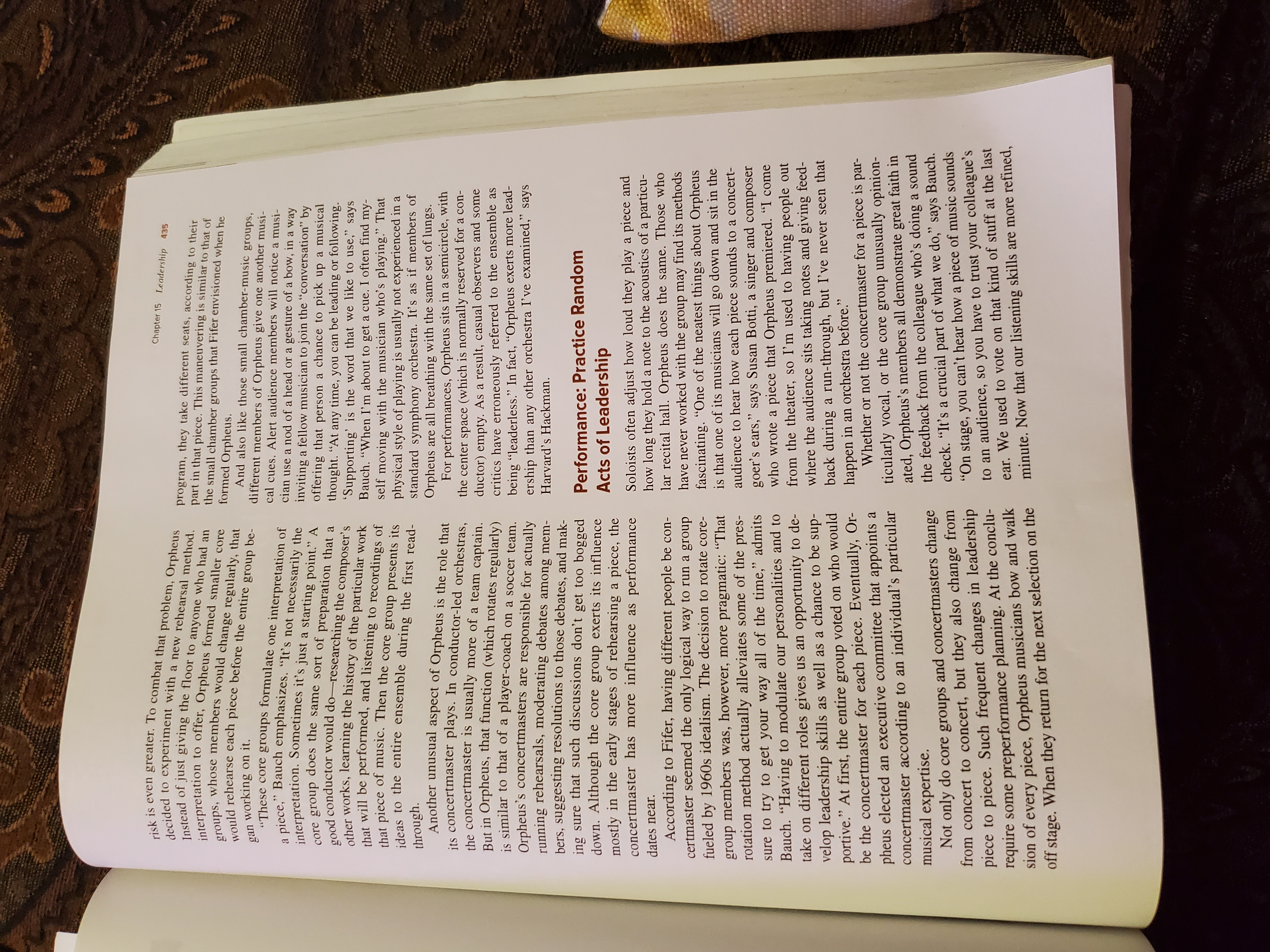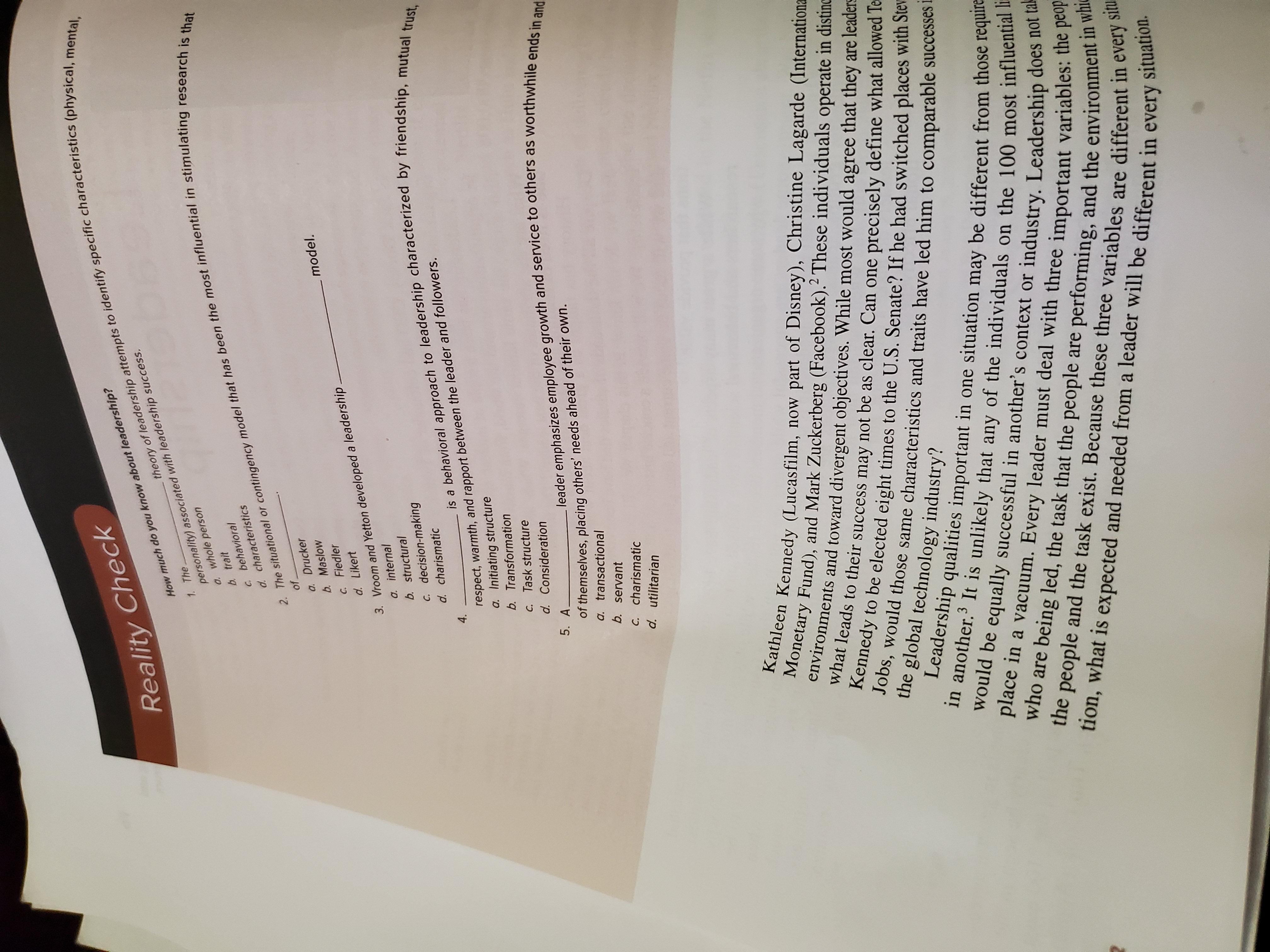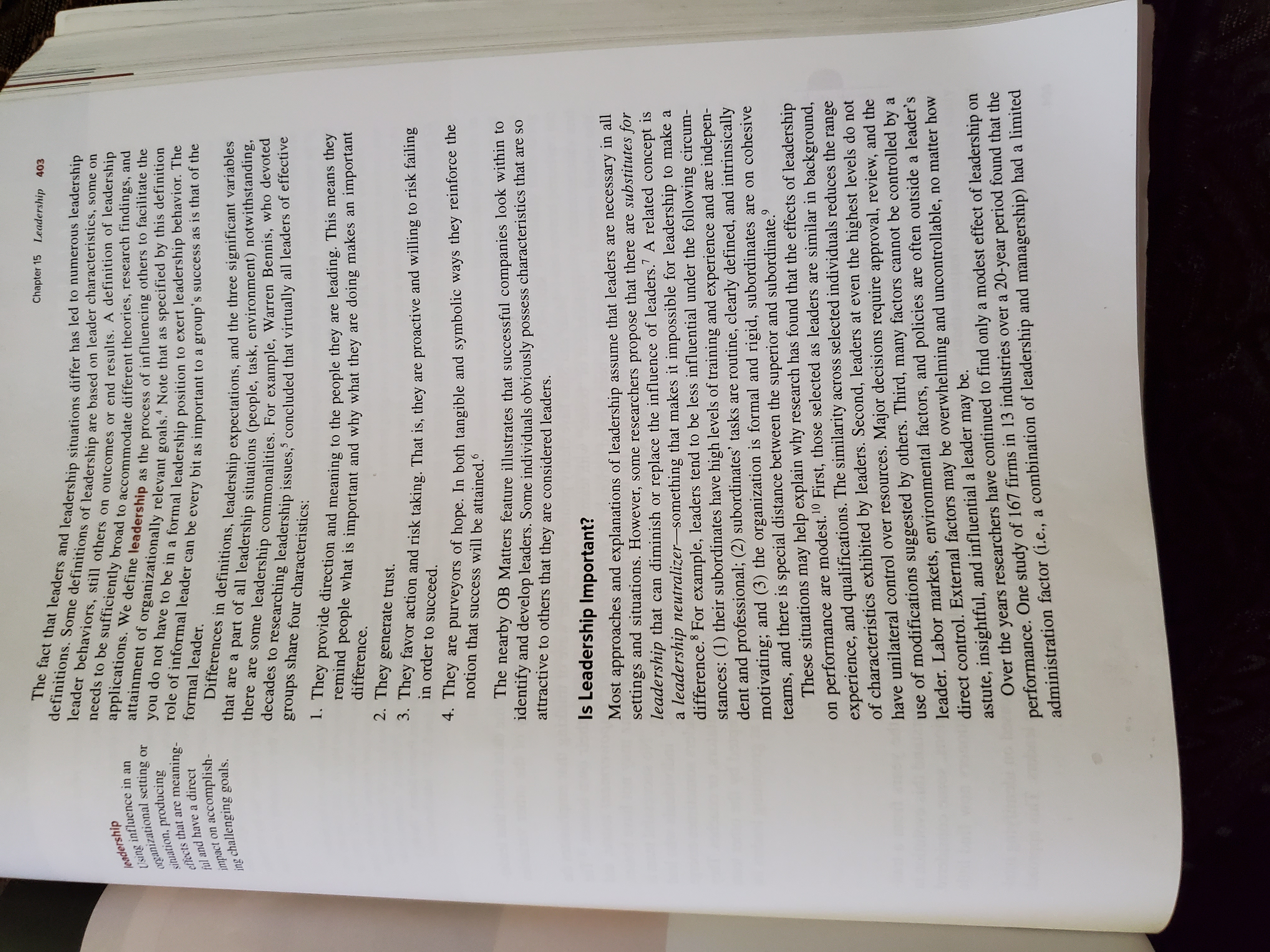Read Case Study 15.1 and answer the following questions:
- Develop a personal definition of leadership with a brief explanation for each of three critical elements.
- Take your definition and its elementsand compare it to the structure and operation of the Orpheus Chamber Orchestra.
- In what specific ways has the comparison changed your assumptions about leadership?
434 Part Four Organizational Processes "I wanted to bring that camaraderie and spirit into a risk Orpheus since 1974, "because you'd be under the thumb of its conductor for the next 30 or 40 years." larger setting. And in order for everyone to be able to deci "Ironically, your conservatory training leaves you ill- communicate more effectively, it seemed necessary to Inste equipped to play in large orchestras," adds Frank do without a conductor." inte Morelli, 40, a bassoonist who joined Orpheus in the late So Fifer invited a select group of musicians to that group 1970s but sometimes also plays in conductor-led groups. first rehearsal, carefully choosing among those who he wow "Presumably, you've devoted so much time to studying knew could take-as well as give-criticism. He gan music because you have a need for self-expression. named the group Orpheus, for the Greek god who cre- If you've studied at a top school for the past four or so ated music so powerful that stones rose up and fol- a pi years, you've also got a certain amount of pride and ego lowed him. "We had no particular method for present- inter invested in your career. And you're self-motivated be- ing interpretations and ideas on a piece, but our spirits CO cause the competition is so steep. But all of those things were high, and we had a great deal of enthusiasm," he go can get in the way when you're sitting in an orchestra recalls. "It was as if we were calling out to anyone who oth with a conductor telling you what to do." would listen. 'Look Ma, no hands!' tha Some observers of the orchestra scene today believe tha that the moral righteousness of Orpheus's early mem- Decision Making: Everyone's a Leader ide bers was prophetic. "The climate in most conductor-led (Just Not All at Once) orchestras is appalling," says Harvey Seifter, 46, Orpheus's executive director, who left the theater world But could they do it? When Fifer's idea first took about two years ago to take on the delicate task of shape, he knew of no preexisting model for a conduc administering to the needs of this self-governing enter- orless group of Orpheus's size-anywhere. So his idea prise. "Orchestras take a lot of very smart people, many was an ambitious one: assembling a number of rene- of whom learned to read music before they learned to gade musicians and building a sustainable enterprise read words, and, if they're violinists, sit them in the last fueled only (at least at first) by idealism and satisfac row of the second-violin section, where they must un- tion. Still, the group pressed on, meeting at Chinese questioningly follow someone who's waving a stick at restaurants, rehearsing in churches, and performing at them. Success is defined as how good you are at get- public libraries and housing projects, because city- ting your bow to leap off your violin at the exact same owned property cost nothing to rent. Eventually, the nanosecond as all of the other violinists' bows." group got a few annual grants from New York's arts That interpretation is in keeping with the results of a commission, created a demo tape, and, in 1974, booked study conducted by Harvard psychology professor a small hall at Lincoln Center for its debut perfor- Richard Hackman. In the early 1990s, Hackman looked mance. In 1979, Orpheus made its first concert tour of at job satisfaction among symphony musicians in 78 or- Europe, and five years later, it signed a recording con- chestras in four countries and found widespread discon- tract with the prestigious Deutsche Grammaphon label. tent. Indeed, in this now well-known study, symphony Even as performances gained recognition and at- members experienced the same levels of job satisfaction tracted larger audiences, rehearsals remained a work in as the federal prison guards whom Hackman had studied earlier. Symphony musicians were, however, happier progress. At first, all 27 members of the group partici- than professional hockey players. pated in every decision that had to be made for each "Most of them adapt," explains Hackman. "But they piece-hundreds of tiny details involving dynamics, often do that by finding other ways to develop musically. phrasing, and tempo. So that Orpheus wouldn't sound One person said that he had to be very careful not to let like dueling stereos, each decision had to be unani his symphony job get in the way of making music." mous. And that could take a while, especially when 27 For Fifer, the inspiration for Orpheus came from his strong-willed musicians were involved, and the buck chamber music experiences back at Juilliard. He found stopped with all of them. "Rehearsals were becoming the sense of intimacy and connectedness that he felt free-for-alls," says Martha Caplin, 48, a violinist with with other musicians in those groups exciting and in- the group since 1982. "We needed twice as many re- spiring, and he longed to find a way to re-create that hearsals just to try all of the ideas." experience on a larger scale. "I loved chamber music's Any organization that operates on consensus risks clarity of sound and flexibility of temperament," he says. the possibility of arriving at utterly wishy-washy deci- sions. If the agreement process is itself chaotic, thatrisk is even greater. To combat that problem, Orpheus Chapter 15 Leadership 435 decided to experiment with a new rehearsal method. Instead of just giving the floor to anyone who had an program, they take different seats, according to their interpretation to offer, Orpheus formed smaller core part in that piece. This maneuvering is similar to that of whose members would change regularly , that the small chamber groups that Fifer envisioned when he would rehearse each piece before the entire group be- formed Orpheus. gan working on it . And also like those small chamber-music groups, "These core groups formulate one interpretation of different members of Orpheus give one another musi- a piece," Bauch emphasizes. "It's not necessarily the cal cues. Alert audience members will notice a musi- interpretation. Sometimes it's just a starting point." A cian use a nod of a head or a gesture of a bow, in a way inviting a fellow musician to join the "conversation" by core group does the same sort of preparation that a offering that person a chance to pick up a musical good conductor would do-researching the composer's thought. "At any time, you can be leading or following other works, learning the history of the particular work "Supporting' is the word that we like to use," says that will be performed, and listening to recordings of Bauch. "When I'm about to get a cue. I often find my- that piece of music. Then the core group presents its self moving with the musician who's playing." That ideas to the entire ensemble during the first read- physical style of playing is usually not experienced in a through. standard symphony orchestra. It's as if members of Another unusual aspect of Orpheus is the role that Orpheus are all breathing with the same set of lungs. its concertmaster plays. In conductor-led orchestras, For performances, Orpheus sits in a semicircle, with the concertmaster is usually more of a team captain. the center space (which is normally reserved for a con- But in Orpheus, that function (which rotates regularly) ductor) empty. As a result, casual observers and some is similar to that of a player-coach on a soccer team. critics have erroneously referred to the ensemble as Orpheus's concertmasters are responsible for actually being "leaderless." In fact, "Orpheus exerts more lead- ership than any other orchestra I've examined," says running rehearsals, moderating debates among mem- Harvard's Hackman. bers, suggesting resolutions to those debates, and mak- ing sure that such discussions don't get too bogged Performance: Practice Random down. Although the core group exerts its influence mostly in the early stages of rehearsing a piece, the Acts of Leadership concertmaster has more influence as performance Soloists often adjust how loud they play a piece and dates near. how long they hold a note to the acoustics of a particu- According to Fifer, having different people be con- lar recital hall. Orpheus does the same. Those who certmaster seemed the only logical way to run a group have never worked with the group may find its methods fueled by 1960s idealism. The decision to rotate core- fascinating. "One of the neatest things about Orpheus group members was, however, more pragmatic: "That is that one of its musicians will go down and sit in the rotation method actually alleviates some of the pres- audience to hear how each piece sounds to a concert- sure to try to get your way all of the time," admits goer's ears," says Susan Botti, a singer and composer Bauch. "Having to modulate our personalities and to who wrote a piece that Orpheus premiered. "I come take on different roles gives us an opportunity to de- from the theater, so I'm used to having people out velop leadership skills as well as a chance to be sup- where the audience sits taking notes and giving feed- portive." At first, the entire group voted on who would back during a run-through, but I've never seen that be the concertmaster for each piece. Eventually, Or- happen in an orchestra before." Whether or not the concertmaster for a piece is par- pheus elected an executive committee that appoints a ticularly vocal, or the core group unusually opinion- concertmaster according to an individual's particular ated, Orpheus's members all demonstrate great faith in musical expertise. the feedback from the colleague who's doing a sound Not only do core groups and concertmasters change check. "It's a crucial part of what we do," says Bauch. from concert to concert, but they also change from 'On stage, you can't hear how a piece of music sounds piece to piece. Such frequent changes in leadership to an audience, so you have to trust your colleague's require some preperformance planning. At the conclu ear. We used to vote on that kind of stuff at the last sion of every piece, Orpheus musicians bow and walk minute. Now that our listening skills are more refined, off stage. When they return for the next selection on the436 Part Four Organizational Processes I think we trust one another more." (Bauch also has had thought I'd do. If I hadn't been forced to do those things, I'm not sure that I ever would have." an opportunity to hone another of his senses-just in case he'll need it on the concert stage: He helped taste- test New York Super Fudge Chunk ice cream for his Questions childhood friends, Ben and Jerry.) 1. What would business organizations such as Kraft Bauch notes that changing core-group participants Foods gain from observing Orpheus in action? and the concertmaster position has given each orchestra member an intensive course in leadership training. "I've 2. Orpheus rotates the concertmaster position among always been a quiet person, but in this group, speaking core-group members. What is the logic of rotating the leader? up is a matter of survival," says Susan Palma-Nidel, a flutist with Orpheus since 1980. "This experience has 3. What are some of the substitutes for permanent allowed me to discover strengths that I didn't know leadership that exist within Orpheus? I had. Not only have I helped lead the group, but I've also been interviewed by the media-something I never Source: Adapted from Ron Lieber, "Leadership Ensemble," Fast Company, May 2000, p. 286, used by permission.CHAPT ER FIFTEEN Leadership Learning Objectives After completing Chapter 15, you should be able to: Compare the situational approaches to . Describe the concept of leadership. leadership. Discuss several traits that are associated . Identify some of the emerging perspectives with leaders. of leadership Summarize the two major behavior Explain how leadership varies in cross- approaches to leadership. cultural contexts. Is Jack Dorsey, CEO and cofounder of Twitter, a great business leader? How about Ginni Rometty, CEO of IBM? Do these and other top managers have what it takes to lead their organizations during good as well as challenging times? Leadership has been a topic of interest, speculation, and debate since the time of Plato. Fuse/Getty Images, RF In organizations around the world, from massive conglomerates to small custom fabrica- tion shops, the same lament emerges: Where are the leaders? Who are the best leaders? What are the attributes of the best leaders? The measure of effectiveness of leading that no one is tired of reading and reflecting about is results achieved. History has taught us a great deal about what leadership is-and about what it isn't. Despite all the thousands of studies that have been conducted, however, there is still a great deal we do not know. In this chapter we will examine some of what we do know about leadership. We will provide a concise historical and contemporary overview of leadership, and we will focus on some current and emerging leadership concepts and consider applica- tions that provide value. While a great many aspects of leadership have been studied, most organizational researchers and behavioral scientists have focused on two important leadership issues: (1) why some organizational members become leaders while others do not, and (2) why some leaders are successful while others are not. Both these issues are thought to be important because leadership is so vital and energizing. It has been suggested that when groups, teams, or organizations are successful, their leadership receives too much credit, and when they fail their leadership gets too much of the blame. Nonetheless, leaders do make a difference, and leadership is a critical variable in shaping organiza- tional effectiveness. What Is Leadership? With so much interest in leadership, it might be assumed that everyone is in general agree- ment about what constitutes leadership. Such is not the case, as can clearly be seen in the diversity of whom we consider to be leaders. A 2016 Time magazine poll of the "100 most influential people" in the world included Sundar Pichai (Google), Tim Cook (Apple), 401Reality Check How much do you know about leadership? - theory of leadership attempts to identify specific characteristics (physical, mental, personality) associated with leadership success. 1. The a. whole person b. trait c. behavioral d. characteristics The situational or contingency model that has been the most influential in stimulating research is that 2. of a. Drucker b. Maslow c. Fiedle model. d. Likert 3. Vroom and Yetton developed a leadership a. interna b. structural c. decision-making d. charismatic 4. Is a behavioral approach to leadership characterized by friendship, mutual trust, respect, warmth, and rapport between the leader and followers. a. Initiating structure b. Transformation C. Task structure d. Consideration 5. A. leader emphasizes employee growth and service to others as worthwhile ends in and of themselves, placing others' needs ahead of their own. a. transactional b. servant C. charismatic d. utilitarian Kathleen Kennedy (Lucasfilm, now part of Disney), Christine Lagarde (Internation Monetary Fund), and Mark Zuckerberg (Facebook). These individuals operate in distin environments and toward divergent objectives. While most would agree that they are leader what leads to their success may not be as clear. Can one precisely define what allowed T Kennedy to be elected eight times to the U.S. Senate? If he had switched places with Stev the global technology industry? Jobs, would those same characteristics and traits have led him to comparable successes Leadership qualities important in one situation may be different from those requir in another. It is unlikely that any of the individuals on the 100 most influential would be equally successful in another's context or industry. Leadership does not ta place in a vacuum. Every leader must deal with three important variables: the peop who are being led, the task that the people are performing, and the environment in wh the people and the task exist. Because these three variables are different in every site tion, what is expected and needed from a leader will be different in every situation.Chapter 15 Leadership 403 The fact that leaders and leadership situations differ has led to numerous leadership definitions. Some definitions of leadership are based on leader characteristics, some on leadership leader behaviors, still others on outcomes or end results. A definition of leadership Using influence in an needs to be sufficiently broad to accommodate different theories, research findings, and organizational setting or applications. We define leadership as the process of influencing others to facilitate the situation, producing attainment of organizationally relevant goals.4 Note that as specified by this definition effects that are meaning- you do not have to be in a formal leadership position to exert leadership behavior. The ful and have a direct formal leader. role of informal leader can be every bit as important to a group's success as is that of the impact on accomplish- ing challenging goals. Differences in definitions, leadership expectations, and the three significant variables that are a part of all leadership situations (people, task, environment) notwithstanding, there are some leadership commonalities. For example, Warren Bennis, who devoted decades to researching leadership issues, concluded that virtually all leaders of effective groups share four characteristics: 1. They provide direction and meaning to the people they are leading. This means they difference. remind people what is important and why what they are doing makes an important 2. They generate trust. 3. They favor action and risk taking. That is, they are proactive and willing to risk failing in order to succeed. 4. They are purveyors of hope. In both tangible and symbolic ways they reinforce the notion that success will be attained.6 The nearby OB Matters feature illustrates that successful companies look within to identify and develop leaders. Some individuals obviously possess characteristics that are so attractive to others that they are considered leaders. Is Leadership Important? Most approaches and explanations of leadership assume that leaders are necessary in all settings and situations. However, some researchers propose that there are substitutes for leadership that can diminish or replace the influence of leaders." A related concept is a leadership neutralizer-something that makes it impossible for leadership to make a difference. For example, leaders tend to be less influential under the following circum- stances: (1) their subordinates have high levels of training and experience and are indepen dent and professional; (2) subordinates' tasks are routine, clearly defined, and intrinsically motivating; and (3) the organization is formal and rigid, subordinates are on cohesive teams, and there is special distance between the superior and subordinate." These situations may help explain why research has found that the effects of leadership on performance are modest. First, those selected as leaders are similar in background, experience, and qualifications. The similarity across selected individuals reduces the range of characteristics exhibited by leaders. Second, leaders at even the highest levels do not have unilateral control over resources. Major decisions require approval, review, and the use of modifications suggested by others. Third, many factors cannot be controlled by a leader. Labor markets, environmental factors, and policies are often outside a leader's direct control. External factors may be overwhelming and uncontrollable, no matter how astute, insightful, and influential a leader may be. Over the years researchers have continued to find only a modest effect of leadership on performance. One study of 167 firms in 13 industries over a 20-year period found that the administration factor (i.e., a combination of leadership and managership) had a limited












